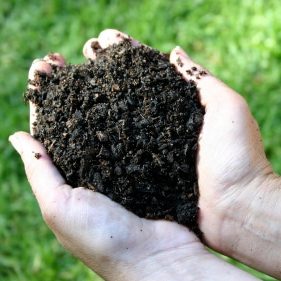Composting is one of the simplest, most effective, economical and environmentally appropriate forms of recycling that every homeowner can use. Composting can significantly reduce landfill use, converting a substantial portion of normal household waste into a beneficial resource for maintaining a sustainable garden and landscape, a natural alternative to chemical fertilizers.
The four components necessary for successful composting are:
- Nitrogen, generally “wet” and green items. Recommended high-nitrogen waste products include food scraps (but not meat products), weeds and grass clippings;
- Carbon sources are usually brown and “dry”, such as leaves, newspaper, cardboard;
- Water in sufficient amounts to keep the mix moist, but not soggy;
- Air to optimize the surface area of the mix: providing sufficient oxygen is the key to successful rapid decomposition.
All organic elements are comprised of carbon and nitrogen components in varying ratios. It’s generally best to maintain about an equal volume of high-carbon and high-nitrogen items in the composting mix, but avoid having more nitrogen than carbon. Both moisture and heat are generated by composting materials. Excessive moisture reduces the amount of air available for decomposition and can create offensive odors. Physically turning the mix to maintain proper moisture and temperature is important for effective composting. For optimum results, temperatures should be maintained at between 135° and 170° F. until all the elements are sufficiently broken down.
Composting can be accomplished with a wide variety of systems. Piling layers of leaves along with other components like food wastes, grass clippings and weeds directly on the ground, or surrounded by an enclosure is one of the simplest techniques. Using a wooden, metal or plastic bin constructed for composting can confine the process into a smaller area. Both of these methods enable existing ground organisms (like fungi, bacteria, worms) to contribute to the process and enrich the ground beneath. The greater the proportion of coarse materials (large weeds, shrub trimmings, small branches), the more air is incorporated into the mix, reducing the need for frequent turning.
Many garden centers offer composting vessels that are specifically designed to facilitate the process for homeowners. Enclosed composting bins and tumblers reduce unpleasant odors, exclude pests and can be conveniently sited in most any garden. They are often constructed with internal baffles that simplify the turning process, optimizing decomposition by enhancing the ability of beneficial organisms to do their job. And the higher internal temperatures they generate enable them to be used year-round.
For millennia society has effectively utilized the principles of composting. The multiple benefits of composting are still so relevant for today’s quality of life; every household should be composting at least some of its wastes. Much detailed information is available from a myriad of sources: your local garden center, your neighbors, organizations concerned with gardening, and of course, online.







